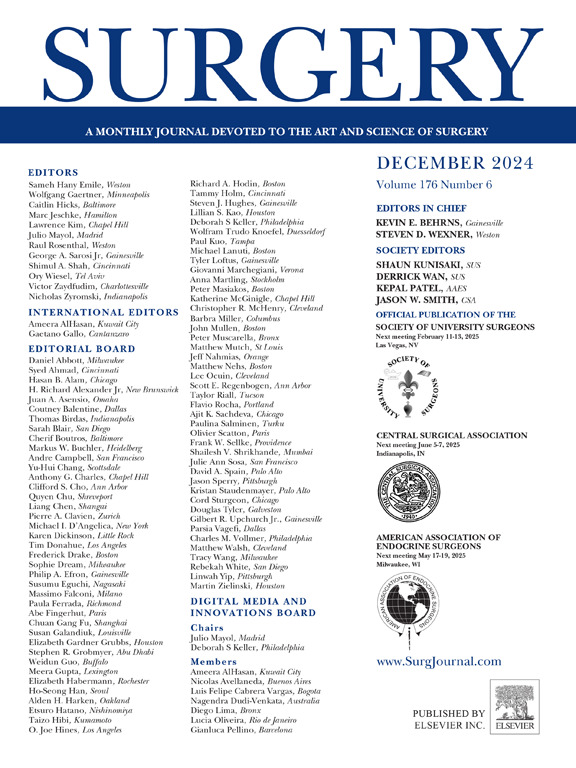Identification of tumor-antigen signatures and immune subtypes for mRNA vaccine selection in muscle-invasive bladder cancer
IF 3.2
2区 医学
Q1 SURGERY
引用次数: 0
Abstract
Background
Muscle-invasive bladder cancer continues to lack reliable diagnostic and prognostic biomarkers. Recently, tumor vaccines targeting specific molecules have emerged as a promising treatment in inhibiting tumor progression, which was rekindled under the background of coronavirus disease-2019 pandemic. However, the application of mRNA vaccine targeting muscle-invasive bladder cancer–specific antigens remains limited, and there has been a lack of comprehensive studies or validations to identify suitable patient subgroups for vaccination. This study aims to explore novel muscle-invasive bladder cancer antigen signatures to identify patients most likely to benefit from vaccination.
Methods
Gene expression profiles of muscle-invasive bladder cancer samples, along with corresponding clinical data, were retrieved from the Cancer Genome Atlas Program. The least absolute shrinkage and selection operator model was applied to develop signatures for stratifying muscle-invasive bladder cancer patients. Prognostic accuracy of each factor was assessed using receiver operating characteristic analysis. Tumor Immune Estimation Resource was employed to visualize the relationship between the proportion of antigen-presenting cells and the expression of selected genes. The CIBERSORT and WGCNA R packages were used to identify differences in immune infiltration levels across muscle-invasive bladder cancer subgroups. Additionally, the STRING database and Cytoscape were used to construct the protein-protein interaction network. CCK-8 and colony formation assays were employed in invitro experiments.
Results
A total of 49 potential tumor antigens were identified. Using least absolute shrinkage and selection operator Cox regression, 14 tumor antigens were selected to develop a risk evaluation signature. The risk score signature can serve as a valuable tool for predicting the outcomes of muscle-invasive bladder cancer patients. Based on differential clinical, molecular, and immune-related gene profiles, muscle-invasive bladder cancer patients were classified into 2 subtypes: the immune “cold” subtype (immune score 1) and the immune “hot” subtype (immune score 2). The immune score signature, developed using a logistic score model, effectively distinguishes between patients more likely to belong to immune score 1 or 2. Notably, patients with a high risk score exhibited a higher proportion of immune score 2 compared to those with a low risk score. Additionally, the prognostic accuracy was significantly enhanced when the risk score and immune score were combined. Different tumor subtypes displayed distinct immune landscapes and signaling pathways. Moreover, novel tumor antigens associated with oxidative stress were identified.
Conclusion
The risk score and immune score signatures based on tumor antigens have identified potential effective neo-antigens for the development of mRNA vaccines targeting muscle-invasive bladder cancer. Patients with low risk score and immune score 1 subtype are more likely to benefit from mRNA vaccination. Additionally, this study highlights the critical role of oxidative stress in modulating the efficacy of the mRNA vaccine.
肌肉浸润性膀胱癌肿瘤抗原特征和mRNA疫苗选择的免疫亚型鉴定
背景:肌肉浸润性膀胱癌仍然缺乏可靠的诊断和预后生物标志物。最近,针对特定分子的肿瘤疫苗成为抑制肿瘤进展的一种有希望的治疗方法,在新冠肺炎大流行的背景下重新点燃。然而,靶向肌肉侵袭性膀胱癌特异性抗原的mRNA疫苗的应用仍然有限,并且缺乏全面的研究或验证来确定适合接种疫苗的患者亚群。本研究旨在探索新的肌肉侵袭性膀胱癌抗原特征,以确定最有可能从疫苗接种中受益的患者。方法:从癌症基因组图谱计划中检索肌肉浸润性膀胱癌样本的基因表达谱以及相应的临床数据。应用最小绝对收缩和选择算子模型建立肌肉浸润性膀胱癌患者的分层特征。采用受试者工作特征分析评估各因素的预后准确性。利用肿瘤免疫估计资源可视化抗原呈递细胞比例与选定基因表达之间的关系。CIBERSORT和WGCNA R包被用于识别肌肉浸润性膀胱癌亚组间免疫浸润水平的差异。此外,利用STRING数据库和Cytoscape构建蛋白-蛋白相互作用网络。体外实验采用CCK-8法和菌落形成法。结果:共鉴定出49种潜在的肿瘤抗原。采用最小绝对收缩和选择算子Cox回归,选择14种肿瘤抗原形成风险评价特征。风险评分特征可以作为预测肌肉浸润性膀胱癌患者预后的有价值的工具。基于不同的临床、分子和免疫相关基因谱,将肌肉浸润性膀胱癌患者分为2个亚型:免疫“冷”亚型(免疫评分1)和免疫“热”亚型(免疫评分2)。使用logistic评分模型开发的免疫评分特征有效区分了更可能属于免疫评分1或2的患者。值得注意的是,与低风险评分的患者相比,高风险评分的患者表现出更高比例的免疫评分2。此外,当风险评分和免疫评分相结合时,预后准确性显着提高。不同的肿瘤亚型表现出不同的免疫景观和信号通路。此外,还发现了与氧化应激相关的新型肿瘤抗原。结论:基于肿瘤抗原的风险评分和免疫评分特征为开发针对肌肉浸润性膀胱癌的mRNA疫苗提供了潜在的有效新抗原。低风险评分和免疫评分1亚型的患者更有可能从mRNA疫苗接种中获益。此外,本研究强调了氧化应激在调节mRNA疫苗效力中的关键作用。
本文章由计算机程序翻译,如有差异,请以英文原文为准。
求助全文
约1分钟内获得全文
求助全文
来源期刊

Surgery
医学-外科
CiteScore
5.40
自引率
5.30%
发文量
687
审稿时长
64 days
期刊介绍:
For 66 years, Surgery has published practical, authoritative information about procedures, clinical advances, and major trends shaping general surgery. Each issue features original scientific contributions and clinical reports. Peer-reviewed articles cover topics in oncology, trauma, gastrointestinal, vascular, and transplantation surgery. The journal also publishes papers from the meetings of its sponsoring societies, the Society of University Surgeons, the Central Surgical Association, and the American Association of Endocrine Surgeons.
 求助内容:
求助内容: 应助结果提醒方式:
应助结果提醒方式:


